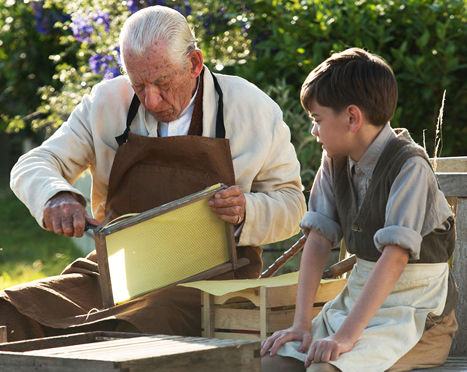
When a character is too popular to die in the public’s imagination (and wallet) after his creator has died, there is an inherent danger in superseding an original author with another who had absolutely nothing to do with the conjuring up of the familiar protagonist, in order to perpetuate the franchise. This sleight of hand is to literature what apocrypha is to the Bible. Dead authors can’t speak from the grave to defend their creations from grave injustices perpetrated against their characters.
This recasting has happened to at least two top pop culture icons and British literary figures: Ian Fleming’s spy James Bond and Sir Arthur Conan Doyle’s sleuth, Sherlock Holmes. Though fraught with danger (i.e., commercial trumping creative considerations), this is not necessarily to say that picking up the storytelling torch should never be done, nor that the subsequent works will always be inferior to those of the founding wordsmith.
The eponymous private detective in screenwriters Billy Wilder and I.A.L. Diamond’s 1970 The Private Life of Sherlock Holmes, as well as the Holmes depictions in James Goldman’s 1971 They Might Be Giants and, best of all, Nicholas Meyer’s 1976 The Seven-Per-Cent Solution, are all worthy additions to and meditations on Holmes, who is arguably one of the greatest characters in English literature. Enter into this sub-genre screen scribe Jeffrey Hatcher’s Mr. Holmes, to which helmer Bill Condon has given the full Masterpiece Theatre treatment.
The distinguished English actor Ian McKellen (who played Frankenstein director James Whale in Condon’s 1998 Gods and Monsters and Gandalf and Magneto in those endless Lord of the Rings and X-Men franchises) plays the title character in Mr. Holmes. At 76, Sir Ian does so as a 93-year-old Sherlock living at what appear to be the white cliffs of Dover and as a younger Holmes, hired for what was to be his last case.
This complicated film flashes back and forth in time, and even finds our man Sherlock at Hiroshima two years after this mostly civilian target was flattened and irradiated by an atomic bomb (if this is what America does when we’re the good guys, imagine what we do when we’re the bad guys!). In any case, the horrific Hiroshima references from 70 years ago emerge out of the Zeitgeist the very week the U.S. and other powers announce an agreement aimed at preventing Tehran from producing nukes (you know, like they all plus Tel Aviv, et al, have already done).
When Sherlock embarked on a new case in Doyle’s exciting adventures he often enthusiastically exclaimed: “The game’s afoot!” But here, in Mr. Holmes, nearly at the end of his game, the nonagenarian Sherlock must use his deductive reasoning skills – and more – to try and solve his ultimate case. Unlike in Doyle’s “The Hound of the Baskervilles” or “The Red-Headed League,” murder and bank robbery are not at stake here. These are mere child’s play in comparison to Sherlock’s final case: Finding himself alone after a long career, striving to figure out the meaning of life.
The lad Roger (the charming Milo Parker) helps Holmes crack the case. He is the son of Sherlock’s housekeeper – no, not Mrs. Hudson, but Mrs. Munro, a widow who lost her husband during the Battle of Britain, played by Laura Linney. For some reason, Linney seems to have developed a specialty of depicting completely unlikable characters. Her Mrs. Munro is a real put-off, as was her Cathy Jamison character in the 2010-2013 Showtime series The Big C – a cancer patient who invaded her teenage son’s privacy, belittled her husband (Oliver Platt), and was thoroughly unpleasant. I watched Linney on Tavis Smiley’s chatfest the other day and she seemed much warmer than the remote, cold characters she has made her forte onscreen.
Viewers who thrilled to the Basil Rathbone-Nigel Bruce 1930s/1940s film series won’t find too much of their adventurousness in the more meditative Mr. Holmes. Indeed, some will likely find this complex rumination on aging and the purpose of existence, that perhaps exploits a big name character Hatcher had no hand in hatching, to be slow moving, dull, uneventful and hard to follow. There are also repeat ponderings on bees and wasps.
When the title character ceremoniously reflects on those people, such as Dr. Watson, who have mattered to him, Sherlockians may wince at the fact that Irene Adler – the one woman for whom Doyle allowed his straight-laced private investigator to express a sort of passion – is oddly omitted. What an oversight – surely a scandal in Bohemia!
More thoughtful moviegoers may enjoy this well acted feature that does to Sherlock Holmes what 1984’s Hugh Hudson-helmed, rather ponderous Greystoke, written by Robert Towne and Michael Austin, did to Edgar Rice Burroughs’ Tarzan. One wonders what Sir Arthur Conan Doyle would make of this revisiting of his greatest fictional creation? This critic would not dare to speak on his behalf – it would take one of those séances Doyle was so fond of to find out.
Of course, fed up with public demands regarding his beloved fictitious private eye, Doyle himself unsuccessfully attempted to kill Holmes off at the Swiss waterfall of Meiringen, in a battle to the death with that “Napoleon of crime,” Professor Moriarty. In any case, let’s hope that the Doyle estate was well paid for this latest iteration of literature’s supreme detective, who has been appearing on the big and little screen since before the cinema could speak. That’s elementary, dear reader.
PG | 104 min
Director: Bill Condon
Writers: Mitch Cullin (original story), Arthur Conan Doyle (characters)
Stars: Ian McKellen, Laura Linney, Hiroyuki Sanada, Milo Parker
Photo: Ian McKellen and Milo Parker. Film website.







